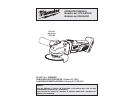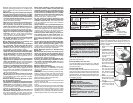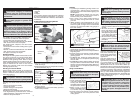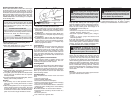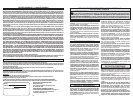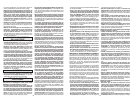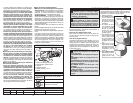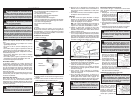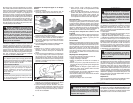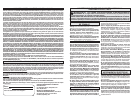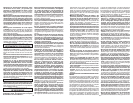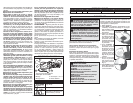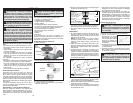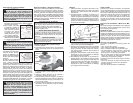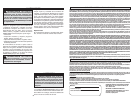
8
9
Aluminum Oxide
For fast cutting, general purpose discs for most
metal jobs. Best for cold-rolled steel, stainless
steel or metals requiring tough, fast cutting, long
lasting abrasives.
Aluminum Zirconia Bi-Cut
Unique grit pattern is arranged in clusters for fast-
er stock removal and cleaning. Ideal for removing
paint from cars, boats, etc. without clogging.
Ceramic
Lasts up to 3 times longer than Aluminum Oxide
Discs. For general metal working. Ideal for tough
jobs.
Fig. 5
Gear
case
Spindle
Backing
pad
Disc nut
Sanding
disc
Selecting Sanding Discs & Grit
Refer to the table below to select the correct type
of sanding disc for your job. Generally, use 24 or
36 grit for heavy stock removal; 50, 60, or 80 grit
for medium stock removal and 120 grit for fi nishing.
Always begin with a coarse grit, using successively
fi ner grits to obtain the desired fi nish. See your
MILWAUKEE Electric Tool Catalog for a complete
list of sanding discs.
Installing Backing Pad and Sanding Discs
1. Remove battery pack.
2. Place tool upside down on a level surface. Re-
move any accessories from spindle.
3. Slip backing pad onto spindle with fl at side away
from gear case.
4. Place sanding disc on backing pad and secure
assembly to spindle with disc nut.
5. To tighten, press the spindle lock button while
turning disc nut clockwise with the spanner
wrench provided.
6. To remove backing pad and sanding disc, remove
battery pack reverse procedure.
Sanding
1. Use a clamp, vise or other practical means to
hold your work, freeing both hands to control
your tool.
2. Hold sander/grinder at 5° to 15° angle to ensure
proper sanding pressure and control. Too great
an angle will result in too much pressure and
could cause excessive wear to the disc and work-
piece. Too small an angle will reduce control.
Fig. 6
For best result use
only this portion of disc
Hold at a
Hold at a
5° to 15° angle
5° to 15° angle
3. To start the tool, grasp the handle and side
handle fi rmly and slide the switch to ON.
4. Allow sanding disc to come to full speed before
beginning to sand. Use long, sweeping, side to
side strokes, advancing forward to produce the
desired fi nish.
5. To stop the tool, release the switch. Make sure
the tool comes to a complete stop before laying
the tool down.
6. To lock-on the switch, slide the switch to ON
and then press down on the front of the switch.
To stop the tool, press and release the switch.
Make sure the tool comes to a complete stop
before laying the tool down.
Cross Sanding
When fi nishing a surface that has been prepared
by a coarse disc or wheel, sand at right angles
to the strokes made by the coarser disc. Finish-
ing marks left from previous sanding are easily
seen and removed for a uniform fi nish. Failure to
cross sand when changing from a coarse disc to
a fi nishing disc may result in deep scratches and
circular marks.
Removing Welds or Hammer Marks
When removing welds or hammer marks, limit
coarse sanding to the immediate area. Use suc-
cessively fi ner grits to smooth surface.
Finishing Metal
Constantly move across the surface. Work faster on
curved surfaces where contact areas are smaller
and pressure is greater. Flat areas may appear at
the end of the stroke when pressure is too heavy.
Ease up on pressure at end of each stroke and
when reversing strokes.
Troubleshooting
Deep scratches and circular marks can result
from:
• Using too coarse a grit
• Using a partially glazed disc
• Dirt or loose metal on the workpiece
• Failure to sand across the grain when changing
from coarse to fi nishing discs
• Failure to use closed coated discs to reduce the
problem of grains working loose and scratching
the workpiece
Bluish discoloration of metal surface indicates:
• Excessive heat caused by circular motion in a
small area
• Excessive pressure
• Use of worn out or glazed discs
ACCESSORIES
For a complete listing of accessories refer to your
MILWAUKEE Electric Tool catalog or go online
to www.milwaukeetool.com. To obtain a catalog,
contact your local distributor or service center.
WARNING Always remove battery pack
before changing or removing accessories. Only
use accessories specifi cally recommended for
this tool. Others may be hazardous.
Maintaining Tool
Keep your tool, battery pack and charger in good
repair by adopting a regular maintenance program.
After six months to one year, depending on use,
return the tool, battery pack and charger to A
MILWAUKEE service facility for:
• Lubrication
• Mechanical inspection and cleaning (gears,
spindles, bearings, housing, etc.)
• Electrical inspection (battery pack, charger,
motor)
• Testing to assure proper mechanical and
electrical operation
If the tool does not start or operate at full power
with a fully charged battery pack, clean the contacts
on the battery pack. If the tool still does not work
properly, return the tool, charger and battery pack,
to a MILWAUKEE service facility for repairs.
MAINTENANCE
Cleaning
Clean dust and debris from charger and tool
vents. Keep tool handles clean, dry and free of oil
or grease. Use only mild soap and a damp cloth
to clean the tool, battery pack and charger since
certain cleaning agents and solvents are harmful to
plastics and other insulated parts. Some of these
include gasoline, turpentine, lacquer thinner, paint
thinner, chlorinated cleaning solvents, ammonia
and household detergents containing ammonia.
Never use flammable or combustible solvents
around tools.
Repairs
For repairs, return the tool, battery pack and char-
ger to the nearest service center.
WARNING To reduce the risk of per-
sonal injury and damage, never im-
merse your tool, battery pack or charger in
liquid or allow a liquid to fl ow inside them.
WARNING To reduce the risk of injury,
always unplug the charger and re-
move the battery pack from the charger or tool
before performing any maintenance. Never
disassemble the tool, battery pack or charger.
Contact a MILWAUKEE service facility for ALL
repairs.



